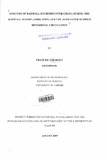| dc.contributor.author | Martey, Francisca | |
| dc.date.accessioned | 2013-05-27T12:22:33Z | |
| dc.date.available | 2013-05-27T12:22:33Z | |
| dc.date.issued | 2007 | |
| dc.identifier.citation | Postgraduate diploma in meteorology | en |
| dc.identifier.uri | http://erepository.uonbi.ac.ke:8080/xmlui/handle/123456789/26236 | |
| dc.description.abstract | The Importance of rainfall forecasting arises from the fact water is important for all
aspects of life; most of the water comes from rain. Hence, precise prediction of rainfall is
necessary. The objective of this study was to analyze the relationship between the low-level
flows patterns and sea surface temperatures associated with extreme rainfall over Ghana.
Monthly rainfall data from 21 stations for 45 years spanning the years 1961-2005 were
used for analysis in the study. Although no station had missing values, the data were subjected to
quality control tests to ensure the consistency and homogeneity of the datasets.
Mass curves were used to check for temporal consistency of the data
The spatial and temporal distributions of Ghanaian rainfall were examined using
principal component analysis (PCA) and time series analysis. The results showed that rainfall is
highly variable in time and in space. Three of the stations namely Akatsi, Saltpond and Takoradi
showed significantly decreasing trends, which were significant as determined from the student's
t-test used to test for differences in the,two means.
Maps were drawn for the wettest' and driest year. The driest map was exactly the mirror ;; . , '
reflection of the wettest years.
The Rotated Principal Component Analysis (RCPA) was used to delineate Ghana into
homogenous climatologically rainfall zones. The resul~~owed that Ghana could be delineated
into five (5) homogenous-rainfall zones. Representative stations for these zones were selected
based on their communality.
Rainfall anomalies were computed in order to determine the years with anomalous
rainfall. Maps were then drawn for the wettest and driest"years from which one was possible to
depict mirror-image of the other. Regions with marked rainfall anomalies are the same regions
that also depicted driest rainfall patterns .
The anomalies of the sea surface temperatures for the months of January, February and
March were used as the predictors for the season April to September. Similarly the sea surface
temperatures and the wind regimes for the period under study were used to predict the extreme
events | en |
| dc.description.sponsorship | University of Nairobi | en |
| dc.language.iso | en | en |
| dc.title | Analysis of rainfall extremes over Ghana during the Rainfall season (April-Sept) and the associated summer Monsoonal circulation | en |
| dc.type | Thesis | en |
| local.publisher | Department of Meteorology Faculty of Science University of Nairobi | en |

